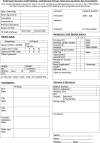Heart team discussion in managing patients with coronary artery disease: outcome and reproducibility
- PMID: 22294559
- PMCID: PMC3329280
- DOI: 10.1093/icvts/ivr157
Heart team discussion in managing patients with coronary artery disease: outcome and reproducibility
Abstract
Recent ESC/EACTS revascularization guidelines advocate a 'Heart Team' (HT) approach in the decision-making process when managing patients with coronary disease. We prospectively assessed HT decision-making in 150 patients analysing personnel attendance, data presented, the 'actioning' of the HT decision and, if not completed, then the reasons why. Additionally, 50 patients were specifically re-discussed after 1 year in order to assess consistency in decision-making. We have two HT meetings each week. At least one surgeon, interventional cardiologist and non-interventional cardiologist were present at all meetings. Data presented included patient demographics, symptoms, co-morbidities, coronary angiography, left ventricular function and other relevant investigations, e.g. echocardiograms. HT decisions included continued medical treatment (22%), percutaneous coronary intervention (PCI; 22%), coronary-artery bypass grafting (CABG; 34%) or further investigations such as pressure wire studies, dobutamine stress echo or cardiac magnetic resonance imaging (22%). These decisions were fully undertaken in 86% of patients. Reasons for aberration in the remaining 21 patients included patient refusal (CABG 29%, PCI 10%) and further co-morbidities (28%). On re-discussion of the same patient data (n = 50) a year later, 24% of decisions differed from the original HT recommendations reflecting the fact that, for certain coronary artery disease pattern, either CABG or PCI could be appropriate.
Figures
References
-
- Kappetein AP, Feldman TE, Mack MJ, Morice MC, Holmes DR, Ståhle E, et al. Comparison of coronary bypass surgery with drug-eluting stenting for the treatment of left main and/or three-vessel disease: 3-year follow-up of the SYNTAX trial. Eur Heart J. 2011;32:2125–34. - PubMed
-
- Taggart DP, Boyle R, de Belder MA, Fox KA. The 2010 ESC/EACTS guidelines on myocardial revascularisation. Heart. 2011;97:445–6. - PubMed
-
- Taylor C, Munro A, Glynne-Jones R, Griffith C, Trevatt P, Richards M, et al. Multidisciplinary team working in cancer: what is the evidence? Br Med J. 2010;340:c951. - PubMed
-
- Lamb BW, Brown KF, Nagpal K, Vincent C, Green JS, Sevdalis N. Quality of care management decisions by multidisciplinary cancer teams: a systematic review. Ann Surg Oncol. 2011;18:2016–25. - PubMed
MeSH terms
Substances
LinkOut - more resources
Full Text Sources
Medical
Miscellaneous


